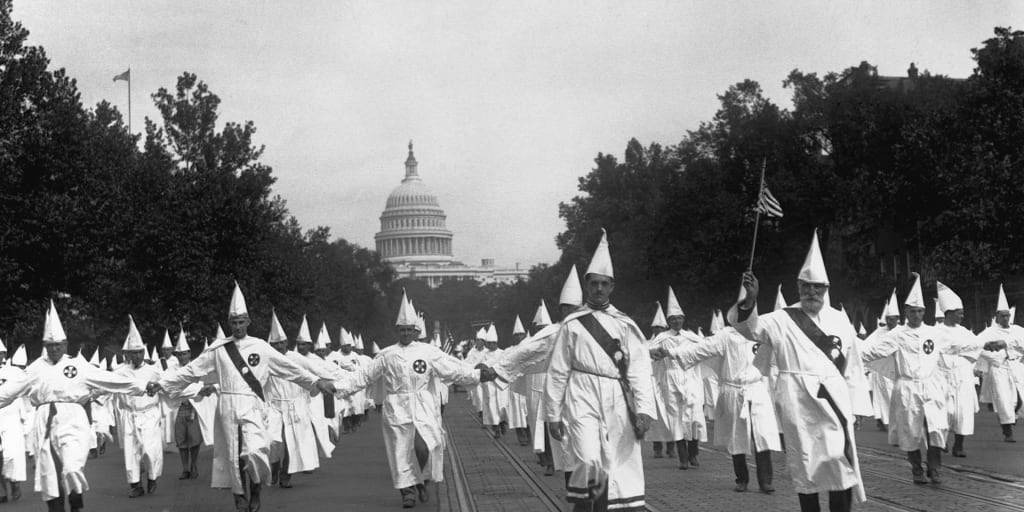The Ku Klux Klan (KKK) is the oldest and most notorious hate group in the United States. For over 150 years, this white supremacist organization has spread hatred, racism and violence across America.
Origins After the Civil War
The KKK traces its roots back to 1865, in the aftermath of the Civil War and the abolition of slavery. Defeated Confederate soldiers in Pulaski, Tennessee formed a secret society which they named the "Ku Klux Klan." The name combined the Greek word for circle, "kyklos," with clan. The founders claimed it began as a harmless social club, but it quickly turned toward intimidating and attacking newly freed black slaves.
The early Klan wore bizarre costumes and pretended to be ghosts of Confederate soldiers. They sought to play on superstitious fears among slaves. However, the pranks soon turned violent, with whippings, attacks and murders. As Reconstruction began in the South, the Klan evolved into a terrorist group dedicated to maintaining white supremacy. Their violence was aimed at keeping blacks from voting, holding office and exercising basic civil rights.
Nathan Bedford Forrest, a former Confederate general, slave trader and accused war criminal, became the first Grand Wizard. Under his leadership in 1868, the Klan grew more bold and ruthless. Dozens of black churches and schools were burned. Over 1,000 black Americans and white allies were murdered within weeks during the 1868 election. This first era of Klan violence accomplished its goals of suppressing black voting and civil rights. With Reconstruction undone, the Klan formally disbanded in 1872. However, its white supremacist principles lived on through Jim Crow laws and norms of segregation.
The Birth and Rebirth of the 20th Century Klan
The Klan was reborn in 1915, inspired by D.W. Griffith's film The Birth of a Nation. The popular movie depicted Reconstruction through racist propaganda, glorifying the original Klan as heroic saviours of the South. Taking advantage of this popularity, William Simmons formed a new KKK that year in Georgia.
The second Klan added anti-Semitic, anti-immigrant and anti-Catholic ideology to their racism. Membership exploded nationwide, reaching 4 million by 1925. This 20th century Klan wielded political power, with local and state officials around the country in their ranks. As a fraternal organization for white Protestants only, the Klan held massive public gatherings. Their burning crosses became the symbol of intimidation toward anyone who challenged their racist visions of America.
Behind this public face of picnics and parades, the 20th century Klan continued its campaign of violence. Between 1915 and 1944, thousands were brutalized and murdered, including victims of particularly gruesome public lynching's. The Klan's unchecked power was finally broken through IRS troubles, scandals, and growing public disgust toward their openly violent philosophy. Membership dwindled in the late 1920s and 30s.
The Civil Rights Era Sparks Klan Resurgence
After WWII, returning black veterans who refused to accept discrimination created new tensions. In response, the Klan experienced its third revival in the 1940s and 50s. This third wave focused its racist terrorism squarely at stopping the civil rights movement.
In 1963, KKK members bombed the 16th Street Baptist Church in Birmingham, killing four young girls. Other civil rights activists, black and white, were beaten, shot, and killed. The murders shocked the nation and exposed the Klan's violence to scrutiny once again. While Federal legislation finally delivered legal equality, the KKK remains active today. Though vastly smaller and marginalized, its members still espouse white supremacy and commit hate crimes.
The Legacy of Racism, Intimidation and Violence
For over 150 years and three distinct eras, the KKK has promoted racism, intimidation and violence. Police, politicians, and everyday citizens joined its ranks, accepting its white supremacist ideology as part of social norms. Lynching's and beatings sent the message that any challenge to white domination would be met with brutality.
While this organization has been discredited and weakened considerably, its bigoted symbols and ideology remain. The Klan's history reflects some of the worst aspects of America's past and the ongoing struggle to fulfil the promise of equal rights for all people. Their legacy of hate demonstrates that extremism festers when left unchecked. The Klan's capacity to re-emerge during times of social change serves as a reminder that vigilance is required to prevent such hate from poisoning communities.


